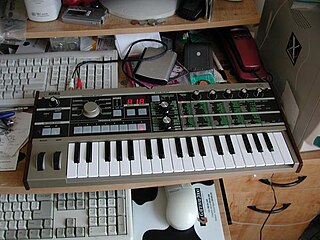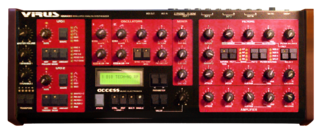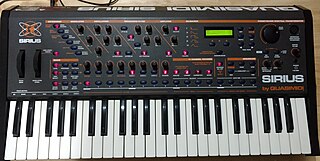
A digital synthesizer is a synthesizer that uses digital signal processing (DSP) techniques to make musical sounds. This in contrast to older analog synthesizers, which produce music using analog electronics, and samplers, which play back digital recordings of acoustic, electric, or electronic instruments. Some digital synthesizers emulate analog synthesizers; others include sampling capability in addition to digital synthesis.

A vocoder is a category of voice codec that analyzes and synthesizes the human voice signal for audio data compression, multiplexing, voice encryption or voice transformation.

An analogsynthesizer is a synthesizer that uses analog circuits and analog signals to generate sound electronically.
A software synthesizer, also known as a softsynth or software instrument, is a computer program or plug-in that generates digital audio, usually for music. Computer software that can create sounds or music is not new, but advances in processing speed now allow softsynths to accomplish the same tasks that previously required the dedicated hardware of a conventional synthesizer. Softsynths may be readily interfaced with other music software such as music sequencers typically in the context of a digital audio workstation. Softsynths are usually less expensive and can be more portable than dedicated hardware.

Reason is a digital audio workstation for creating and editing music and audio developed by Swedish software company Reason Studios. Reason emulates a rack of hardware synthesizers, samplers, signal processors, sequencers, and mixers, all of which can be freely interconnected in an arbitrary manner. Reason can be used either as a complete virtual music studio or as a set of virtual instruments to be used with other sequencing software in a fashion that mimics live performance.
A rompler is an electronic music instrument that plays pre-fabricated sounds based on audio samples. In contrast to samplers, romplers do not record audio and have limited or no capability for generating original sounds. The term rompler is a portmanteau of the terms ROM and sampler. Both may have additional sound editing features, such as layering several waveforms and modulation with ADSR envelopes, filters and LFOs.
The Yamaha AN1x is a DSP-based analog modeling synthesizer, produced by Yamaha Corporation from 1997 to 1998, and was marketed as an "analog physical modelling control synthesizer".

The Korg OASYS is a workstation synthesizer released in early 2005, 1 year after the successful Korg Triton Extreme. Unlike the Triton series, the OASYS uses a custom Linux operating system that was designed to be arbitrarily expandable via software updates, with its functionality limited only by the PC-like hardware.

The microKORG is a MIDI-capable virtual analog synthesizer/vocoder from Korg featuring DSP analog modelling. The synthesizer is built in such a way that it is essentially a Korg MS-2000 with programmable step arpeggiator, a less advanced vocoder, lack of motion sequencing, lack of an XLR microphone input, and in a smaller case with fewer real-time control knobs.

The Korg DW-8000 synthesizer was an eight-voice polyphonic hybrid digital-analog synthesizer 61-note keyboard instrument released in 1985. By the time of its launch Korg had already begun a common trend in 1980s synthesizer design: using numerical codes to access or change parameters with the Korg Poly-61, which was widely regarded as the company's first 'knobless' synthesizer. This was a move away from the heavily laden, complex control panels of earlier designs.

The Access Virus is a virtual analog synthesizer made by the German company Access Music GmbH. It was first produced in 1997 and has since been upgraded frequently, with the company releasing new models about every two years. Early models include the Virus A, Virus B, and Virus C series, each available in various hardware configurations. In November 2005, the Virus TI series was released, including the 61-key Virus TI Keyboard and the 37-key Virus TI Polar. A small desktop model was released in February 2008 called the Virus TI Snow. A revision of the TI series called TI2 came out in March 2009, featuring faster digital signal processing (DSP) controllers, 16 voice polyphony, more effects in the effect section and a slightly changed design. The Virus series also has come out with two software plugin versions: TDM for Pro Tools and VST for TC Electronic Powercore series. The term Access Virus can be used to refer to any one of these synthesizers.

The Korg MS2000 is a virtual analog synthesizer produced by the Japanese electronic musical instrument manufacturer Korg.

The Korg Wavestation is a vector synthesis synthesizer first produced in the early 1990s and later re-released as a software synthesizer in 2004. Its primary innovation was Wave Sequencing, a method of multi-timbral sound generation in which different PCM waveform data are played successively, resulting in continuously evolving sounds. The Wavestation's "Advanced Vector Synthesis" sound architecture resembled early vector synths such as the Sequential Circuits Prophet VS.

The Alesis Ion is an analog modeling synthesizer. It was presented to the public on the Summer NAMM of 2002. Unlike the Alesis Andromeda, Alesis's analog synthesizer, its sounds are synthesized using DSP chips to mimic the sound of analog audio circuitry and components.

A synthesizer is an electronic musical instrument that generates audio signals. Synthesizers generate audio through methods including subtractive synthesis, additive synthesis, and frequency modulation synthesis. These sounds may be shaped and modulated by components such as filters, envelopes, and low-frequency oscillators. Synthesizers are typically played with keyboards or controlled by sequencers, software, or other instruments, often via MIDI.
Casio's SD Synthesizers were a late-1980s line of hybrid digital-analog synthesizers featuring a resonant analog filter. SD synthesis was very similar to traditional DCO-analog synthesis, with the main difference being that some of the SD digital waveforms' harmonic spectrums changed temporally, or dynamically in relation to the amplitude envelope. SD synthesis is used in six Casio synthesizers and home keyboards released in 1987 and produced until 1991, when Casio exited the synthesizer market completely and focused solely on pure consumer keyboards. Due to some programming limitations plus Casio's poor marketing, the SD synths never gained wide popularity and are now fairly rare in the second-hand marketplace. There still exists a small but devoted fanbase who insist that SD synthesis, particularly as expanded in the high-end model HT-6000, was overlooked and highly underrated.

The Sirius is a keyboard "groove-synth," featuring a subtractive hybrid-tone-generation synthesizer referred to as DTE synthesis introduced in 1997 by Quasimidi. The unit featured both real-time and step sequencers sequencer with pattern- and song-modes, capable of acting basic drum machine, groove-box, or sound-module.

The CZ series is a family of low-cost phase distortion synthesizers produced by Casio in the mid-1980s. Eight models of CZ synthesizers were released: the CZ-101, CZ-230S, CZ-1000, CZ-2000S, CZ-2600S, CZ-3000, CZ-5000, and the CZ-1. Additionally, the home-keyboard model CT-6500 used 48 phase distortion presets from the CZ line. The CZ synthesizers' price at the time of their introduction made programmable synthesizers affordable enough to be purchased by garage bands. Yamaha soon introduced their own low-cost digital synthesizers, including the DX-21 (1985) and Yamaha DX100, in light of the CZ series' success.

The Korg Z1 is a physical modelling sound synthesiser released in 1997. Touted as a polyphonic Prophecy, the Z1 implements 13 synthesis types, all derived from the original OASYS synthesizer.















